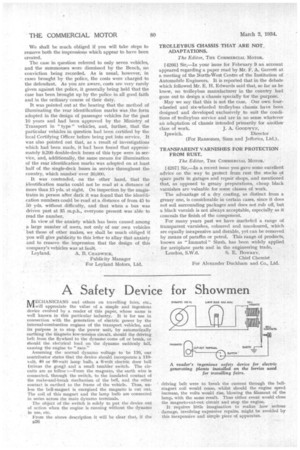A Safety Device for Showmen
Page 40

If you've noticed an error in this article please click here to report it so we can fix it.
it a ECHANICIANS and others on travelling fairs, etc.,
will appreciate the value of a simple and ingenious device evolved by a reader of this paper, whose name is well known in this particular industry. It is for use in connection with the generation of electric power by the internal-combustion engines of the transport vehicles, and its purpose is to stop the power unit, by automatically earthing the magneto low-tension circuit, should the driving belt from the flywheel to the dynamo come off or break, or should the electrical load on the dynamo suddenly fall, causing the engine to "race."
Assuming the normal. dynamo voltage to be 110, our contributor states that the device should incorporate a 110volt, 40 or 60-watt lamp. bulb, a 6-volt electric door hell (Minus the gong) and a small tumbler switch. The circuits are as follow :—From the magneto, the earth wire is connected, through the switch, to the insulated contact of the make-and-break mechanism of the bell, and the other contact is earthed to the frame of the vehicle. Thus, unless the bell-magnet is energized the magneto is cut out. The coil of this magnet and the lamp bulb are connected in series across the main dynamo terminals.
The object of the switch is solely to put the device out of action when the engine is running without the dynamo in use, etc.
From the above description it will be clear that, if the B26
driving belt were to break the current through the bellmagnet coil would cease, whilst should the engine speed increase, the volts would rise, blowing the filament of the lamp, with the same result. Thus either event would close the magneto-cut-out circuit and stop the engine. It requires little imagination to realize how serious damage, involving expensive repairs, might be avoided by this inexpensive and simple piece of apparatus.




























































































